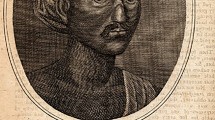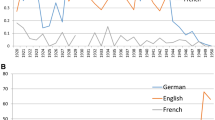Abstract
Introduction
Japan’s first encounter with Western Medicine was in 1543. Japanese doctors were introduced to surgical treatment by Portuguese missionaries who visited Japan mainly to propagate Christianity and trade with Japan. Until that time, Japanese doctors have treated internal diseases by using mainly traditional Chinese medicine and had not experienced modern Western medicine, particularly surgery.
Discussion
In 1639, the Tokugawa shogunate issued the policy of seclusion (national isolation policy) and prohibited contacts with foreign countries except the Netherlands and China. All European culture came into Japan through Dutch traders. Japanese doctors studied medical books written in Dutch, but could not imagine that the original versions had been written by German doctors. Japanese doctors who studied Dutch medicine founded private schools in various places nationwide, prompting the development of Western medicine. In 1868 the Edo shogunate collapsed, and the newly established Meiji government opened Japan to the rest of the world. In an effort to introduce European civilization, which had been closed to the Japanese under the 250 years, the Meiji government followed Western styles when framing policy and building social systems. In terms of medicine, for the sake of reaching the world’s highest level, the government decided to learn from Germans. Many of the young Japanese doctors travelled to Germany. However, as a world war loomed ahead, interchange with foreign countries became difficult. Peace was threatened, and even the progress of science was impeded. Although the United States led the world in the medical field, some Japanese doctors still studied in Germany after World War II to learn their medical traditions and look at the starting point of clinical medicine; and they continued the interchange between Japan and Germany. While continuing active relationship, in 1990, the German and Japanese Surgical Societies was established, and planned to hold a triennial joint meeting alternately in Germany and Japan.
Conclusion
Ever since the Meiji government decided to learn medicine in German, it has been a status symbol and a dream for Japanese medical scientists to submit papers to German academic journals, particularly Langenbeck’s Archives of Surgery. Surprisingly, 125 years ago, Dr. Hashimoto had already reported on the surgical treatment, and six other papers were submitted by some Japanese surgeons in its early period. I hope that surgeons in Germany and Japan, both of which have an over 300-year history, will work hard and maintain scientific exchange while learning from each other’s strong points.
Abstrakt
Die deutsch-japanischen Beziehungen zwischen Chirurgen hat eine fast 300-jährige Tradition. Deutsche, westliche Medizin wurde zuerst von holländischen Ärzten in Japan praktiziert. Vor nahezu 200 Jahren hat der Würzburger Arzt und Chirurg, Phillip Franz von Siebold in Dejima in Nagasaki gynäkologische, orthopädische, neurochirurgische und otolaryngologische Operationen ausgeführt und seit 1824 in einem Krankenhaus eine medizinische Schule gegründet. Auf Veranlassung des Emporers Meiji öffnete sich die japanische Medizin 1870 aus nationaler Isolation. Mediziner aus Deutschland, wie Erwin von Bälz und Julius K. Scriba lehrten an der Tokyo-Universität deutsche Medizin und Chirurgie. Fritz Härtel, ein Schüler von v. Schmieden, Frankfurt, war der erste Professor für Chirurgie in der Universität Osaka. In der zweiten Hälfte des 19. Jahrhunderts haben viele junge japanische Ärzte und Chirurgen in Deutschland, vor allem in Berlin um die fundamentale neue Entwicklung chirurgischer Techniken bei Bernhard von Langenbeck und Theodor Billroth gelernt und bei dem Pathologen Rudolf Virchow und dem Bakteriologen Robert Koch studiert. Shibasaburo Kitasato arbeitete in Robert Kochs Institut und etablierte in Tokyo die School of Medicine an der Keio Universität 1917. Hayari Miyake, später Chairman der Chirurgischen Klinik in Fukuoka, Kyushu Universität, ist Johann von Mikulicz-Radecki in Breslau während eines mehrjährigen, zweimaligen Aufenthaltes wie ein Sohn aufgenommen worden, er hat die ersten Gastroskopien und Magenoperationen mitgemacht und erlernt. Hayari Miyake hat mehrfach vor allem auf seinem Gebiet der Neurochirurgie in Langenbecks Archiv und der Deutschen Zeitschrift für Chirurgie publiziert.
Nach 1945 hat sich die japanische Medizin nach Amerika ausgerichtet, aber unmittelbar enge Beziehung zur deutschen Chirurgen weitergeführt. Intensive Beziehungen wurden von Yoshio Mishima (Tokyo-Universität), Yoshiki Hiki (Kitasato-Universität), Masayoshi Okada (Tokyo-Universität), Keiichi Maruyama (National Cancer Center) und Masaki Kitajima (Keio-Universität) mit deutschen Chirurgen und der Deutsche Gesellschaft für Chirurgie gepflegt. 1990 gründeten Yoshio Mishima zusammen mit G. Heberber, München, und H.J. Peiper, Göttingen, die Deutsch-Japanische Surgical Society; regelmäßige Joint-Meetings führten zu einem engen Austausch junger deutscher Chirurgen in Japan und japanischer Chirurgen in deutschen Kliniken; neben Hannover, München, Düsseldorf, Heidelberg waren japanische Chirurgen über Jahre in Ulm zur Ausbildung in Gastrointestinaler- und Pankreaschirurgie. In Langenbecks Archiv haben seit 1865 regelmäßig japanische Chirurgen publiziert. Dr. Hashimoto von Tokyo berichtete 1885 über chirurgische Verfahren bei Exostosen, Aneurysmen, Leberabszess und congenitalen Atresien. Ein Schüler von Hayari Miyake, Fukuoka, H. Hashimoto publizierte seine Erfahrungen mit Daten zur lymphomatösen Thyreoiditis in Langenbecks Archiv. Als Ausdruck der engen fachlichen Beziehung zwischen japanischen und deutschen Chirurgen sind führende japanische Chirurgen Mitglied im Editor und Editorial Board von Langenbeck’s Archives of Surgery: Masaki Kitajima (Tokyo), Yoshiki Hiki (Tokyo), Keiichi Maruyama (Tokyo), Seiki Matsuno (Sendai), Yujii Nimura (Nagoya), Toshiharu Yamaguchi (Tokyo), Akimasa Nakao (Nagoya), Sachiko Tanaka (Osaka), Naoki Hiki (Tokyo), Toshihide Imaizumi (Konogawa), Hiroshi Shimada (Yokohama) und Wataru Kimura (Yamagata).

















Similar content being viewed by others
References
Ohmura T (1992) In: Kraas H, Hiki Y (eds) Kooperation in Vergangenheit und Gegenwart, 300 Jahre deutsch-japanische Beziehungen in der Medizin. Springer, Tokyo, pp 7–10
Nakanishi A, Tsuchiya R, Ito T, Miyasaka M (eds) (1999) The introduction of Chinese medicine to Japan, the history of surgery in Nagasaki, a memento of the 9th world congress of the international gastro-club. Dept. of Surgery, University School of Medicine, Nagasaki, pp 1–6
Saito M (1992) In: Kraas H, Hiki Y (eds) Die deutsche Medizzin in Japan im Rahmen der Hollandkunde, 300 Jahre deutsch-japanische Beziehungen in der Medizin. Springer, Tokyo, pp 11–19
Keil G (1999) In: Thiede E, Keil G, Hiki Y (eds) German Medicine in Japan, Philipp Franz von Siebold and his Era. Springer, Berlin, pp 127–134
Hiki S, Hiki Y (1999) In: Thiede E, Keil G, Hiki Y (eds) Siebold as a surgeon, physician and medical teacher in Japan, Philipp Franz von Siebold and his Era. Springer, Berlin, pp 71–82
Matsuki A (1970) Annals of anesthetic history. Seishu Hanaoka, a Japanese pioneer in anesthesia. Anesthesiology 32(5):446–450
Vianden HH (1992) In: Kraas H, Hiki Y (eds) Japan im Zeichen der Meiji-Reformen, 300 Jahre deutsch-japanische Beziehungen in der Medizin. Springer, Tokyo, pp 36–44
Yamamoto K (2005) Medical history for medical student, Shindan & Chiryo
Kraas E (1992) In: Kraas H, Hiki Y (eds) Chirurgie: Deutsche in Japan-Japaner in Deutschland, 300 Jahre deutsch-japanische Beziehungen in der Medizin. Springer, Tokyo, pp 65–84
Chiruruginnen in der japanischen Moderneß120 Jahre Geschichte bis zur Gegenwand Deusche Gesellschaft für Chirurgie-Mitteilungen (2004) 4-04:364 366
Hiki S, Hiki Y (2005) Professor von Mikulicz-Radecki Breslau. Langenbeck Arch Surg 390:182–185
Miyake Ha (1923) Das primäre Duodenum mobile, Langenbeck Arch. Chir., Bd.122 , H.1: 269
Hashimoto, H.: Struma Ilymphomatosa Hashimoto, Langenbeck Arch. Chir., Bd. 97, H.1: 219 1912.
Miyake Hi (1992) In: Kraas H, Hiki Y (eds) Erinnerung an meine Zeit in KielT, 300 Jahre deutsch-japanische Beziehungen in der Medizin. Springer, Tokyo, pp 231–234
Wada N, Yoshiki Hiki (2008) Professor (em.) of Surgery, Kitasato University, Japan, Mastery in Surgery. Langenbeck Arch Surg 393:115
Kikuchi S, Hiki Y et al (2000) Tumor volume, a novel prognostic factor in patients who undergo curative resection for gastric cancer. Langenbeck’s Arch Sug 385:225–228
Kikuchi S, Hiki Y, Shimao H et al (2004) Survival after surgical treatment of early gastric cancer:surgical techniques and long term survival. Langenbecks Arch Sug 69–74
Hiki Y, Nishi M (1992) Left upper abdominal quadrant evisceration. Langenbecks Arch Chir Suppl (Kongressbericht 1992) 136-141
Kraas E, Hiki Y (1992) 300 Jahre Deutsch–Japanische Beziehungen in der Medizin. Springer, Tokyo, pp 85–91
Kitajima M (2007) Mastery in surgery professor Masaki Kitajima. Langenbeck Arch Surg 392:767–768
Maruyama K, Sasako M, Kinoshita T (1992) Wert der systematischen erweiterten Lymphknotendissektion—Ergebnisse in Japan (Role of systematic extended lymph node dissection: Japanese experience). Langenbecks Arch Chir Suppl 130–135
Maruyama K, Sasako M, Kinoshita T, Sano T, Katai H (1999) Review "Lymph-node dissection in GI cancer", can sentinel node biopsy indicate rational extent of lymphadenectomy in gastric cancer surgery? Fundamental and new information on lymph-node dissection. Langenbeck’s Arch Surg 384:149–157
Author information
Authors and Affiliations
Corresponding author
Additional information
Masaki Kitajima, M.D., FACS(hon), FRCS(hon), GSS(hon) President of International University of Health and Welfare
Yoshiki Hiki, M.D., Dr. h.c., GSS(hon), ISS/SIC(hon), FJCS(hon) Professor Emeritus of Kitasato University
Rights and permissions
About this article
Cite this article
Kitajima, M., Hiki, Y. Langenbeck's Archives—an international communication forum between Japanese and German surgeons. Langenbecks Arch Surg 395 (Suppl 1), 57–67 (2010). https://doi.org/10.1007/s00423-010-0628-z
Received:
Accepted:
Published:
Issue Date:
DOI: https://doi.org/10.1007/s00423-010-0628-z




